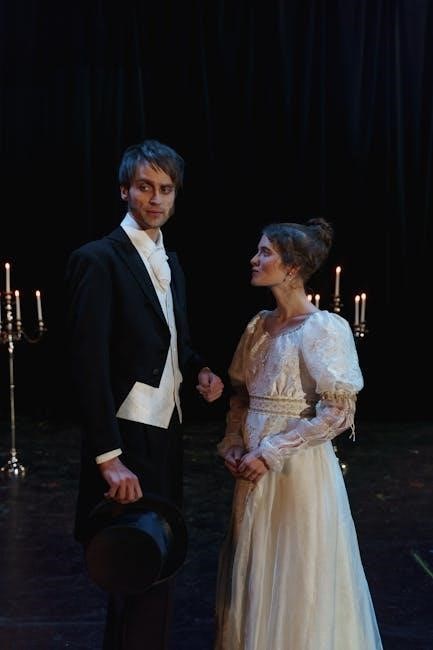The introduction to Romeo and Juliet Act 1 provides background information on the play
The play summary is available online in pdf format, providing an overview of the story.
The document summarizes Act 1 of Romeo and Juliet, introducing the two feuding families of Capulet and Montague in Verona, Italy.
This summary is part of a larger collection of resources, including analysis and study guides, designed to aid in understanding the play.
The summary covers the key events of the play, including the introduction of the main characters and the conflict between the families.
It also provides context for the rest of the play, including the tragic outcome of the story.
The summary is a useful resource for students and readers looking to understand the play and its themes.
The play’s story is a classic tale of love and conflict, and the summary provides a concise overview of the plot.
The online pdf format makes it easily accessible to readers.

Act 1 Scene 1 Analysis
Analysis of scene one is crucial for understanding the play’s opening scene clearly online
Scene 1 Description
The scene begins with two Capulet servants, Sampson and Gregory, walking through the streets of Verona, exchanging banter and discussing their hatred for the Montagues. They are joined by Abram and Balthasar, who engage in a heated conversation about the feud between the two families. The scene sets the tone for the rest of the play, showcasing the deep-seated hatred and tension between the Montagues and Capulets. The description of the scene helps readers understand the context of the play and the events that unfold. The servants’ conversation reveals the long-standing feud between the two families, which ultimately leads to the tragic outcome of the play. The scene description provides a foundation for analyzing the rest of the play.

Understanding the Feud
Feud between Montagues and Capulets drives the plot and characters actions slowly
The Feud Between Montagues and Capulets
The feud between Montagues and Capulets is a central theme in Romeo and Juliet Act 1, driving the plot and characters’ actions. This long-standing rivalry between the two families is rooted in a deep-seated hatred for each other, with each side seeking to outdo the other in wealth, status, and power. The feud is fueled by a series of incidents, including a brawl between the Montague and Capulet servants, which ultimately leads to the Prince’s warning to cease the violence. The feud sets the stage for the tragic events that unfold, as the two families’ hatred for each other ultimately leads to the downfall of the star-crossed lovers, Romeo and Juliet, and ultimately, the reconciliation of the two families. The feud is a complex and multifaceted theme that adds depth and complexity to the play.

The Role of the Prince
The Prince plays a crucial role in maintaining order in Verona city always
The Prince’s Warning
The Prince’s warning is a pivotal moment in Act 1, as he threatens to punish the feuding families if they continue to fight. This warning is delivered after a brawl breaks out between the Montague and Capulet servants, and the Prince is forced to intervene to restore order. The warning serves as a reminder to the families of the consequences of their actions and sets the tone for the rest of the play. The Prince’s authority is established, and his role in maintaining peace in Verona is emphasized. The warning also foreshadows the tragic events that will unfold as the families continue to clash. The Prince’s words are a desperate attempt to prevent further violence and bloodshed in the city. The warning is a crucial element in the play’s exploration of conflict and resolution.
Characters are introduced with distinct personalities and traits in Act 1 scenes
Romeo is introduced as a young man in Act 1, with a focus on his emotional state and personality traits. He is shown to be a romantic and impulsive character, with a deep sense of passion and emotion. The introduction of Romeo sets the stage for his role in the play, and provides insight into his motivations and actions. Through his interactions with other characters, Romeo’s introduction reveals his sense of humor and his tendency to be introspective. The character of Romeo is complex and multi-dimensional, and his introduction in Act 1 lays the foundation for his development throughout the play. Overall, Romeo’s introduction is a crucial element of the play, and provides a deeper understanding of his character.
No Fear Shakespeare Summary
Provides original text with modern translation and notes for clarity and understanding purposes always
Modern Translation
A modern translation of Romeo and Juliet Act 1 provides a clear understanding of the play’s language and themes, making it accessible to readers.
The translation is presented in a side-by-side format, allowing readers to compare the original text with the modern version.
This format is helpful for readers who may struggle with the original language, as it provides a clear and concise explanation of the play’s dialogue and stage directions.
The modern translation is also useful for readers who want to gain a deeper understanding of the play’s themes and characters.
Overall, the modern translation of Romeo and Juliet Act 1 is a valuable resource for readers, providing a clear and accessible understanding of the play’s language and themes, and is often included in Romeo and Juliet Act 1 pdf documents.

Tragic Outcome
The tragic outcome is a result of the feud and love between families in Verona city streets and homes every day always
Resolution of the Feud
The resolution of the feud between the Montagues and Capulets is a pivotal aspect of the play, as it brings an end to the violence and hatred. The tragic outcome of the two lovers’ deaths ultimately leads to the reconciliation of their families. The Prince’s warning and the families’ realization of their senseless feud contribute to the resolution. The play’s conclusion shows the two families coming together, united in their grief and regret. This resolution is a testament to the devastating consequences of the feud and the redemptive power of love and forgiveness. The ending is a commentary on the senselessness of violence and the importance of peace and unity in Verona.